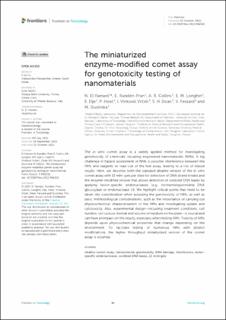| dc.contributor.author | El Yamani, Naouale | |
| dc.contributor.author | Rundén-Pran, Elise | |
| dc.contributor.author | Collins, Andrew Richard | |
| dc.contributor.author | Longhin, Eleonora Marta | |
| dc.contributor.author | Elje, Elisabeth | |
| dc.contributor.author | Hoet, Peter | |
| dc.contributor.author | Vrček, Ivana Vinković | |
| dc.contributor.author | Doak, Shareen H. | |
| dc.contributor.author | Fessard, Valérie | |
| dc.contributor.author | Dusinska, Maria | |
| dc.date.accessioned | 2022-11-07T13:20:04Z | |
| dc.date.available | 2022-11-07T13:20:04Z | |
| dc.date.created | 2022-11-04T12:16:16Z | |
| dc.date.issued | 2022 | |
| dc.identifier.citation | Frontiers in Toxicology. 2022, 4, 986318. | en_US |
| dc.identifier.uri | https://hdl.handle.net/11250/3030463 | |
| dc.description.abstract | The in vitro comet assay is a widely applied method for investigating genotoxicity of chemicals including engineered nanomaterials (NMs). A big challenge in hazard assessment of NMs is possible interference between the NMs and reagents or read-out of the test assay, leading to a risk of biased results. Here, we describe both the standard alkaline version of the in vitro comet assay with 12 mini-gels per slide for detection of DNA strand breaks and the enzyme-modified version that allows detection of oxidized DNA bases by applying lesion-specific endonucleases (e.g., formamidopyrimidine DNA glycosylase or endonuclease III). We highlight critical points that need to be taken into consideration when assessing the genotoxicity of NMs, as well as basic methodological considerations, such as the importance of carrying out physicochemical characterization of the NMs and investigating uptake and cytotoxicity. Also, experimental design—including treatment conditions, cell number, cell culture, format and volume of medium on the plate—is crucial and can have an impact on the results, especially when testing NMs. Toxicity of NMs depends upon physicochemical properties that change depending on the environment. To facilitate testing of numerous NMs with distinct modifications, the higher throughput miniaturized version of the comet assay is essential. | en_US |
| dc.language.iso | eng | en_US |
| dc.rights | Navngivelse 4.0 Internasjonal | * |
| dc.rights.uri | http://creativecommons.org/licenses/by/4.0/deed.no | * |
| dc.title | The miniaturized enzyme-modified comet assay for genotoxicity testing of nanomaterials | en_US |
| dc.title.alternative | The miniaturized enzyme-modified comet assay for genotoxicity testing of nanomaterials | en_US |
| dc.type | Peer reviewed | en_US |
| dc.type | Journal article | en_US |
| dc.description.version | publishedVersion | en_US |
| dc.rights.holder | © 2022 El Yamani, Rundén-Pran, Collins, Longhin, Elje, Hoet, Vinković Vrček, Doak, Fessard and Dusinska. | en_US |
| dc.source.volume | 4 | en_US |
| dc.source.journal | Frontiers in Toxicology | en_US |
| dc.identifier.doi | 10.3389/ftox.2022.986318 | |
| dc.identifier.cristin | 2069147 | |
| dc.relation.project | EC/H2020/814425 | en_US |
| dc.relation.project | EC/H2020/814572 | en_US |
| dc.relation.project | EC/H2020/952404 | en_US |
| dc.relation.project | EC/H2020/857381 | en_US |
| dc.relation.project | NILU: 120152 | en_US |
| dc.relation.project | NILU: 119012 | en_US |
| dc.relation.project | NILU: 121048 | en_US |
| dc.relation.project | NILU: 119125 | en_US |
| dc.relation.project | NILU: 119011 | en_US |
| dc.source.articlenumber | 986318 | en_US |
| cristin.ispublished | true | |
| cristin.fulltext | original | |
| cristin.qualitycode | 1 | |

